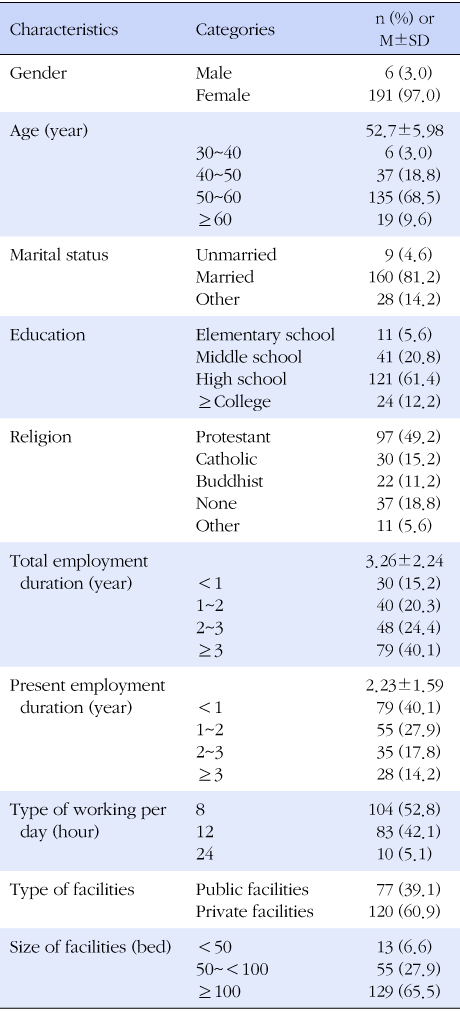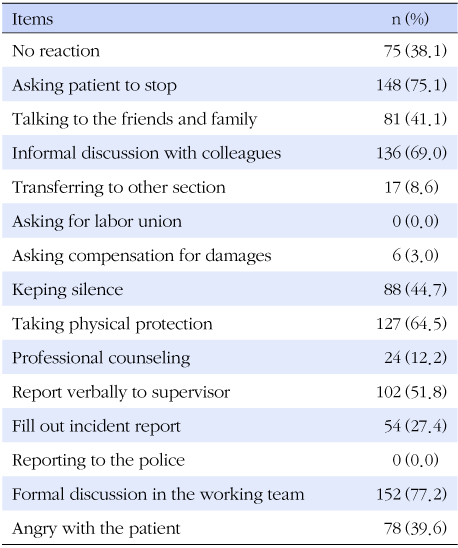Articles
- Page Path
- HOME > J Korean Acad Community Health Nurs > Volume 23(2); 2012 > Article
-
Original Article
- Caregivers' Experience of Violence and Coping with It in Nursing Homes
- Eun-Young Lee, Hee-Sun Kang, Kyung-Hee Kim, Kyung-Sook Park
-
Journal of Korean Academy of Community Health Nursing 2012;23(2):134-143.
DOI: https://doi.org/10.12799/jkachn.2012.23.2.134
Published online: June 30, 2012
1Graduate, Graduate School, Chung-Ang University, Seoul, Korea.
2Associated Professor, Department of Nursing, Chung-Ang University, Seoul, Korea.
3Professor, Department of Nursing, Chung-Ang University, Seoul, Korea.
• Received: January 28, 2012 • Accepted: June 18, 2012
Copyright © 2012 Korean Academy of Community Health Nursing
- 627 Views
- 11 Download
- 3 Crossref
Abstract
-
Purpose
- The purpose of this study is to investigate verbal, physical and sexual violence to caregivers in nursing home workplaces.
-
Methods
- This cross-sectional study was done from October 17 to 31, 2011 at eight randomly selected nursing homes in Seoul and one nursing home in Gyeonggi, South Korea. This study explored their responses to violence and violent situations, and then investigated on how caregivers coped with workplace violence.
-
Results
- The results of this study show that most caregivers in nursing homes experience some form of violence. Verbal violence was more frequent than physical or sexual violence. Verbal and physical violence occurred most often while they were changing the clothes of patients and sexual violence occurred most often while they were showering patients. After experiencing violence, caregivers most often dealt with the situation by informing their colleagues of what was happened.
-
Conclusion
- These results suggest that institutional and administrative measures must be implemented to increase the prevention of violence against caregivers and to improve effective measures to deal with violence once it has occurred. Violence in nursing homes can be reduced through the combination of appropriate responses by caregivers and proper education of both patients and caregivers.
- 1. Åström S, Bucht G, Eisemann M, Norberg A, Saveman B. Incidence of violence towards staff caring for the elderly. Scand J Caring Sci 2002;16(1):66–72.
- 2. Åström S, Karlsson S, Sandvide A, Bucht G, Eisemann M, Norberg A, et al. Staff's experience of and the management of violent incidents in elderly care. Scand J Caring Sci 2004;18(4):410–416.
- 3. Gates D, Fitzwater E, Succop P. Relationships of stressors, strain, and anger to caregiver assaults. Issues Ment Health Nurs 2003;24(8):775–793.
- 4. Gates D, Fitzwater E, Succop P. Reducing assaults against nursing home caregivers. Nurs Res 2005;54(2):119–127.
- 5. International Council of Nurses Joins New Initiative Against Workplace Violence in Health Sector. Qld Nurse 2003;22(1):20.
- 6. Isaksson U, Graneheim UH, Åström S. Female caregivers' experiences of exposure to violence in nursing homes. J Psychiatr Ment Health Nurs 2009;16(1):46–53.
- 7. Jang SJ. Relationship between experience of patients' violent behaviors and burnout of psychiatric nurses 2004;Seoul: Seoul National University; Unpublished master's thesis.
- 8. Kim NY. A study on the influence of sexual violence severity and negative life attitude on the mental health 2002;Seoul: Yonsei University; Unpublished master's thesis.
- 9. Kim SY. Violence episodes and responses of emergency room nurse by patients and their guardiand 2007;Daejeon: Eulji University; Unpublished master's thesis.
- 10. Kim SY. The recognition of nurses about sexual harrassment 2008;Daegu: Kyungpook National University; Unpublished master's thesis.
- 11. Kweon MJ. The study on the job satisfaction of the nurse for the welfare facilities for the old 2009;Wonju: Sangji University; Unpublished master's thesis.
- 12. Lanza ML. Assult response questionnaire. Issues Ment Health Nurs 1988;9(1):17–29.
- 13. Lim SY. A study on the general stress of social workers influenced by client violence 2008;Gwangju: Honam University; Unpublished master's thesis.
- 14. Lundstrom M, Graneheim UH, Eisemann M. Influence of work climate for experiences of strain. Learn Disabil Pract 2005;8(1):32–38.
- 15. Ministry of Government Legislation. Guidelines on sexual harassment at the workplace 2010;Retrieved November 20, 2010. from http://www.law.go.kr
- 16. Ministry of Health and Welfare. Nursing home status in Korea 2011 2010;Retrieved December 31, 2010. from http://www.mw.go.kr
- 17. Ministry of Health and Welfare. Caregivers status in Korea 2011;Retrieved April 30, 2011. from http://www.stat.mw.go.kr
- 18. O'Connell B, Young J, Brooks J, Hutchings J, Lofthouse J. Nurses' perceptions of the nature and frequency of aggression in general ward settings and high dependency areas. J Clin Nurs 2000;9(4):602–610.
- 19. Oh SG. A study on countermeasures of sexual violence crime 2011;Seoul: Konkuk University; Unpublished master's thesis.
- 20. Park HC. A study on a clint violence experienced social worker's post traumatic stress 2010;Seoul: Sogang University; Unpublished master's thesis.
- 21. Park HJ. Exposure of intensive care unit nurses to workplace violence 2011;Seoul: Chung ang University; Unpublished master's thesis.
- 22. Park MS. Influence of job stress on job satisfaction of caremanager 2009;Daegu: Daegu Haany University; Unpublished master's thesis.
- 23. Seol JH. Studies on clients' violence in a social welfare facility for the elderly and social workers' perception of it. J Welf Aged 2006;34:133–162.
- 24. Smith-Pittman MH, McKoy YD. Workplace violence in healthcare environments. Nurs Forum 1999;34(3):5–13.
- 25. Son M. Violence in the emergency department: A study on the experiences of ED nurses 1997;Seoul: Hanyang University; Unpublished master's thesis.
- 26. Tak S, Sweeney MH, Alterman T, Baron S, Calvert GM. Workplace assaults on nursing assistants in US nursing homes: A multilevel analysis. Am J Public Health 2010;100(10):1938–1945.
- 27. Yang JK. Analysis of current situation and problems of long-term care workers 2010;Seoul: Korea University; Unpublished master's thesis.
- 28. Yoon KA, Jin KN. Client violence and job stress in the nursing homes. J Korean Gerontol Soc 2007;27(2):285–298.
- 29. Yun JS. A study on job satisfaction and violence experience by ED nurses 2004;Ulsan: Ulsan University; Unpublished master's thesis.
Figure & Data
References
Citations
Citations to this article as recorded by 

- Relationship between Experience of Client Violence and Turnover Intention among Workers in Long-Term Care Facilities for Older Adults: Focusing on Nurses, Social Workers, and Care Workers
Seunghoon Choi, Hyeri Shin, Minah Lee, Kimyung Han
Nursing Reports.2023; 13(1): 549. CrossRef - The Experiences of Long Term Care Workers Who care for People with dementia at Home
Bongsook Yih
Journal of the Korea Academia-Industrial cooperation Society.2016; 17(2): 394. CrossRef - Influence of Job Stress, Coping Strategies on life satisfaction in long-term care workers -focused in Gyeonggi-do-
Hyemin Hwang, Juok Kim
Journal of the Korea Academia-Industrial cooperation Society.2015; 16(9): 6152. CrossRef

 KACHN
KACHN





 PubReader
PubReader Cite
Cite

